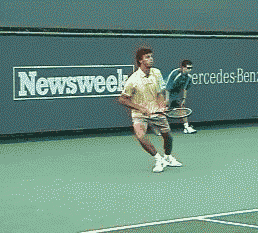|
TennisOne Lessons Deceleration Training Lee Taft It's great to be fast on the court! When you can cover wide shots like they were right next to you, and get to drop shots as if you only were taking one step to get there, the game gets easier. Well, it can happen! The only thing is; the trick may not be in accelerating faster, it may be decelerating faster!
Have you noticed how some players seem to move effortlessly? It looks as though they are not really running fast, rather appear to float across the court. Well, no doubt there are some athletes born with greater speed and quickness than others, and it takes them less effort to accelerate and get to the ball. But because tennis is a multi-directional change of direction sport the agility that a tennis player needs to possess is much more than just running fast. The real key to movement and preparation is the ability to change directions and re-accelerate once again. Keep in mind that you can't re-accelerate until you have finished your deceleration from another direction. So the quicker you are at stopping the faster you can be at running. The players that do this the best are the quickest.
In this case imagine they are positioned on the baseline and well into the doubles alley. Now, once the shot has been made the player must get back into position, somewhere near the center line. Before returning to the center of the court, or running to retrieve the next shot by the opponent, the player must stop or decelerate in order to re-accelerate. The first move, after the deceleration, begins with a crossover recovery step, and then the decision to either shuffle or sprint back to the center. Regardless of the speed required to accelerate and recover back into the court, none of this occurs until proper deceleration takes place first. Here are some fine points to look for.
To see this better in your mind; if the player is moving at a 90 degree angle to the side of the court, let's say directly along the baseline, than the outside foot must be on or close to being on the baseline or 90 degree angle in order to stop the body's momentum along that line. This is more commonly seen on clay. You can visually track the foot placement and see the player's direction of movement because of the angle the foot was sliding at. The outside foot must plant wide enough to stop the body quickly and meet the momentum forces, yet not so wide that the tennis player slips and falls. On the other hand, if the foot plants too close under the hips the player can stumble and trip and then be drawn yet further outside the court.
The goal is to use the deceleration as the first step in acceleration. Meaning, don't be so passive with your foot work and balance when decelerating, but rather quickly get going the other way! Use the angle created to stop you momentum to re-create momentum going the other way. Drive off that outside foot to get moving back into the court. Here are some fine points: The arm action used to increase acceleration flows from the follow through position of the shot. The racquet arm in most cases will be high above the opposite shoulder from the follow through; and now this arm can be driven down and back, like a sprinter, to aid the knee drive of the opposite leg. The knee drive helps increase the power of the push off leg through a theory of action reaction. It is this coordination of the arm and leg action that increases speed.
Your comments are welcome. Let us know what you think about Lee Taft's article by emailing us here at TennisOne . |

